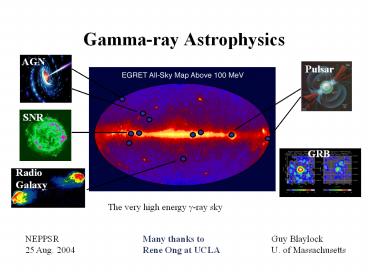Gamma-ray Astrophysics - PowerPoint PPT Presentation
Title:
Gamma-ray Astrophysics
Description:
Title: Ong page 1 of VHE astro Author: Trial User Last modified by: Trial User Created Date: 8/5/2004 1:23:59 PM Document presentation format: On-screen Show – PowerPoint PPT presentation
Number of Views:133
Avg rating:3.0/5.0
Title: Gamma-ray Astrophysics
1
Gamma-ray Astrophysics
NEPPSR 25 Aug. 2004
Guy Blaylock U. of Massachusetts
Many thanks to Rene Ong at UCLA
2
Why gamma rays?
Radio
- provide insight into the most energetic and
- violent sources
- penetrate dust to see to the core of the galaxy
3
The Science of g-rays
4
The VHE g ray sky (2000)
Gamma ray physics is a young and rapidly growing
field!
5
Experimental Techniques
Satellite
Wavefront array
Cherenkov Telescopes
6
Detector Energy Ranges
Broad energy coverage requires multiple
techniques.
Log E (eV)
6 9 12
15 18
21
Atmospheric Cherenkov
Satellite
N2 Fluorescence
Wavefront Array
7
Satellite experiments
A g-ray entering the detector produces an e e
pair, whose direction and energy are measured.
EGRET
8
Cherenkov Imaging Telescopes
The image of a shower approaching along the
telescope axis is an ellipse pointing to the
center of the field of view.
9
Cherenkov Wavefront Detectors
STACEE solar array (Albuquerque)
A flat Cherenkov wavefront only a few nanoseconds
thick is measured by an array of detectors.
Careful timing determines the direction of the
wavefront.
10
Identifying g-ray Showers
Orientation angle (a)
- Use shower shape and orientation to discriminate
between gammas and hadrons - Rejection factor 300 for a single telescope
Shower profile in atmosphere
11
Shower Movies
2 TeV proton shower
2 TeV gamma shower
12
VHE g-ray Sources
Broadly speaking, there are two types of
sources
- 1. Electromagnetic
- Rotating magnetized object (Pulsar)
- Gravitational
- Core collapse of a massive star (SN and its
remnant) - Accretion onto a compact object (Black hole and
other)
Crab nebula
These are somewhat intertwined eventually
acceleration is done electromagnetically, and
often both are involved.
BH model
13
Pulsars
Crab Pulsar
- Highly magnetized rotating neutron star
accelerates charged particles. - These charges escape along open magnetic field
lines in jets. - In the process, they radiate and scatter photons
to high energies. - Details depend on specific models.
14
Supernova Remnants
- Collapse of massive star.
- Outer layers ejected with
- v 1-2 x 107 m/s.
- Shell expands and shock front forms as it sweeps
up material from ISM. - In 104 yrs, the blast wave slows and
dissipates. - The particle acceleration mechanism is under
study.
15
Active Galactic Nuclei
- AGN are likely powered by accretion onto BHs of
106 109 solar masses. - Matter falling in from rotating accretion disk
powers relativistic jets. - Time variations indicate gamma rays probe to
within 10 Schwarzschild radii of the BH ! - Leading candidate for UHE cosmic rays.
AGN model
16
Dark Matter
- The matter in galaxies can be determined from
rotation curves. - Galaxies are bound by mass far bigger, and
distributed more diffusely, than baryonic mass.
- Known baryonic matter accounts for 4 of the
universe. - About 23 of the universe appears to be made of
weakly interacting (non-clumping) heavy
non-relativistic stuff not comprised of known
particles. - i.e. WIMPs
17
Neutralino Annihilation
Flux ( r / Mx ) 2 s
Galactic Center
- The lightest SUSY particle (neutralino?) is a
leading candidate for the WIMP. - Density should be biggest in centers of galaxies
- Annihilation to g-rays might be detectable.
18
The Galactic Center
Three experiments have seen VHE g rays from the
GC this year!
HESS 9 Aug 2004
VHE g contours overlayed on radio (21cm)
map. Bright spot in the center is Sgr A.
Probably too bright for neutralinos
19
The Structure of Spacetime
- Look for energy dependent arrival time difference
in rapidly varying signal
- Quantum gravity
- Discrete space-time foam affects the
propagation of short wavelength light - Results in dispersion (even in vacuum)
20
Future g-ray Telescopes
GLAST
In space
MAGIC
VERITAS
Telescope Arrays
HESS
CANGAROO
21
GLAST Satellite Telescope
- GLAST LAT Instrument
- Si tracker
- CsI calorimeter
- Anti-coincidence veto
- Launch in 2007
22
HESS
- Jan 2004
H.E.S.S. An array of four 12m telescopes in
Namibia
23
HESS Operations
4 Telescope Event
Detected Sources Crab Nebula PKS
2155-304 Galactic Center
- 4 photoelectron
- threshold
- 2/4 telescope
- trigger
- Rate 250 Hz.
24
VERITAS
first of four telescopes
V ery E nergetic R adiation I maging T elescope
A rray S ystem
V E R I T A S
Kitt Peak Arizona
- All major systems tested.
- Telescope 1 operational in fall 2004.
25
CANGAROO
Collaboration of Australia and Nippon for a
Gamma Ray Observatory in the Outback
Four 10m telescopes in Woomera, Australia Data
taking started in March 2004
26
MAGIC
- Jan 2004
Camera
Single 17m reflector. Started operation in 2004.
La Palma, Canary Islands
27
Predictions for 2020































